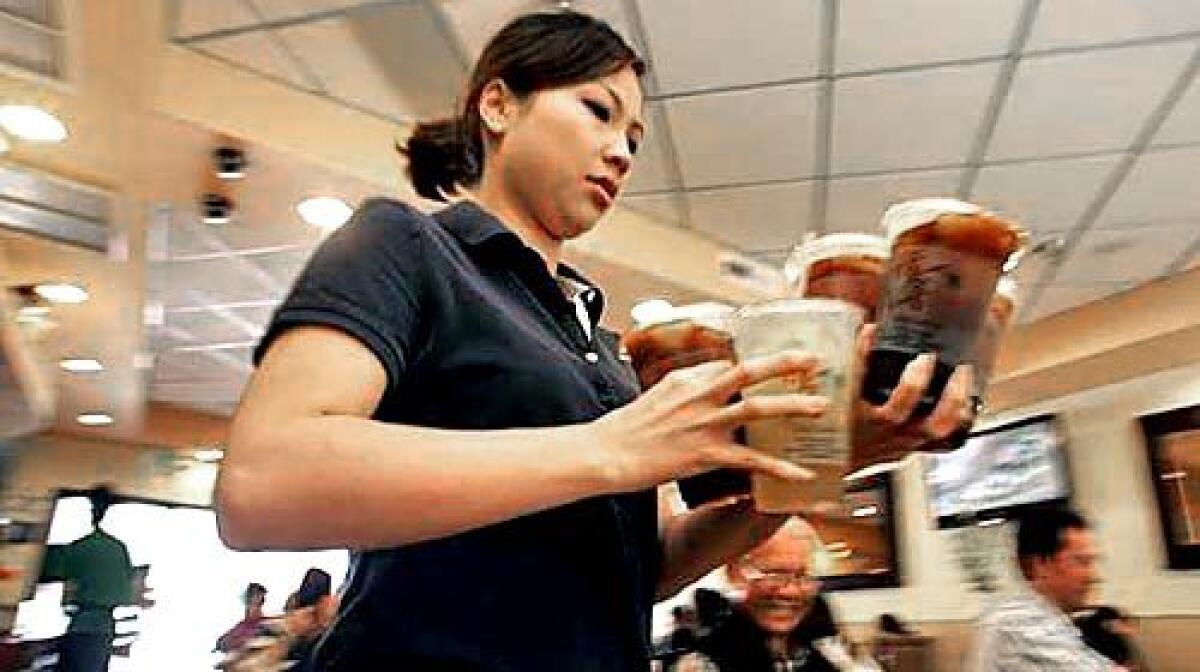Expat comfort food: The quirky mix at L.A.’s Hong Kong-style coffee shops

- Share via
POLISHING off their cream-filled crepes and fruit smoothies, the after-movie crowd at Garden Café drifts homeward around 1 a.m. But by 3 a.m., a fresh wave of customers -- most in goth-inspired club-wear -- fills the tables at this classic Hong Kong-style coffee shop. Even at this hour, the kitchen pumps out dishes from a long, amazingly varied list: escargot, Russian borscht, Spam-topped noodle soup, German-style pork knuckle, French toast, Chinese chow fun and a panoply of Italian-style pastas re-imagined for Asian palates.
Dozens of similar restaurants around the San Gabriel Valley -- clones of typical coffee shops in Hong Kong -- began to open in the 1980s, and today several -- including Litz Restaurant, J&J Restaurant and Ledo Cafe -- are Southern California institutions. Fine dining they are not. They’re diner-style, comfort-food depots where a quirky range of global-fusion cravings can be allayed at any hour.
But lately, some hipper, more vibrant updates of the old-school places are springing up. They’re lots of fun, with more creative food and drink and menus geared to more worldly, contemporary tastes -- a trip to modern Asia without a plane ticket.
The saga of their predecessors, the Hong Kong coffee shops that evolved from that city’s once-ubiquitous Russian cafes, would make great TV melodrama.
Russian refugees fleeing the Bolshevik regime after 1917 settled in Shanghai, where their cafes thrived in the European concessions. In 1949, in the wake of mainland Communist takeovers, the Russians fled again, this time to Hong Kong, where Chinese from all over the mainland crowded the city as well.
Melting pot
AS Hong Kong grew and flourished, the “work-driven melting-pot society created an ideal situation for the coffee shops,” says Able Kwan, founder of Southern California’s two Red Ant Cafes (his previous Helena restaurants, which opened in 1983, were among the first Hong Kong-style coffee shops in this area).
Chanteclair and Cherikoff’s, the two most famous of Hong Kong’s Russian-owned eating places, gave residents of that city, especially young people of the post-World War II era, their first taste of Western food served in individual portions (as opposed to Chinese family-style platters) with Western cutlery.
The Russian places, more like bakeries or delis with small attached dining areas, maintained long hours to compete with other casual restaurants in a city where prepared food was available around the clock.
Prix fixe menus with several courses were a big draw, and that tradition is reflected on the menu of L.A.’s Hong Kong coffee shops, which often offer their own versions of Russian-inspired French and Continental dishes and individual prix fixe-style dinners of fish and meat.
Over the years, Hong Kong coffee shops began serving Chinese food and reflecting British influences. The jolt-inducing, triple-strength, Hong Kong-style milk tea and sandwiches trimmed of their crusts are essential coffee shop fare.
Vestiges of this history can be seen at some of the San Gabriel Valley’s newer East-West cafes, including some that serve Chinese dishes exclusively and others that emphasize recent trends in Western cooking.
At Cafe Spot in Alhambra, a fashionably dressed couple sip Merlot and eat steamed clams in garlic-wine broth and Chinese dumpling soup. They’re oblivious to the energetic buzz from the communal table at the other end of the restaurant.
Around the room, customers have ordered dishes as diverse as Kobe steak served with vegetables, grilled eel with curry-fried rice and steamed milk custard topped with puff pastry.
In the hierarchy of our local Hong Kong-style coffee shops, this one could be described as a bridge between the old-school diner-like Regent Café in Alhambra and the chic Yume Kitchen in San Gabriel.
Dinner buffet
THE Regent once offered a proper English roast beef Sunday dinner buffet, says Wilber Woo, retired president of Cathay Bank in Chinatown. Today that roast beef dinner, with fresh veggies and a bacon-bit garnished baked potato, appears on the regular menu. And in keeping with tradition, the Regent serves freshly made, hot cabbage borscht, a serviceable French onion soup topped with a flaky pastry crust and decent Chinese shrimp dumplings in broth -- which may be a lure if you’re hungry in the middle of the night.
But late hours aren’t necessarily the attraction at the more progressive of L.A.’s Hong-Kong-style coffee shops. Most draw crowds instead for their weekend breakfasts of Eastern, Western and fusion dishes; their afternoon tea specials; and beverage bars where a host of teas, juices, smoothies and other refreshers are mixed and served to customers.
There is no better place to get a feel for this new breed than at the amiable Yume Kitchen in San Gabriel. Yume’s glass facade gives it the look of a sparkling, transparent box. The simple décor has a retro feel with muted, mint-green walls and chrome-legged, molded plastic chairs. Yet the butcher paper-covered tables recall bistro setups.
Yume serves beautifully prepared and modestly priced prixfixe Western meals plus a galaxy of Chinese noodle soups and duck, which you can get either Hakka style in broth with noodles or roasted the European way resting in a shallow pool of demi-glace sauce with a cylinder of lightly crushed, herbed potatoes.
Although there are also some Japanese-influenced dishes such as fillet of sole fingers under a shower of spicy togarashi (red pepper), Yume’s menu is infinitely more focused than those of the old-time coffee shops and its food a quantum leap in quality.
Red Ant Cafe, a stone’s throw east of Yume Kitchen in San Gabriel’s Sunny Plaza, has a snappy logo, an industrial-modern dining room and a menu with up-to-date selections. The “Health Zone” category lists mostly vegetable entrees, and there’s a house blend of white and nutty-tasting red bran “healthy rice” also used to make congee (rice porridge) for the weekend breakfast.
At the other end of the decadence spectrum, there’s Red Ant’s filet mignon wrapped in puff pastry, like a mini beef Wellington. Not only is the meat quality respectable (and you’re paying $10.95), but it also will arrive medium rare, if requested, with a well-constructed pepper sauce on the side. Somewhat simpler but absolutely delicious is grilled pork shoulder, lightly anointed with a slightly fruity-tasting sauce. At Jazz Cat Cafe, a Taiwanese representative of the new-school places, the walls are painted with a band of instrument-playing felines. The requisite drink bar dispenses icy fruit slushes, fresh fruit juice and variations on classic milk tea flavored with perfumey osmanthus blossom, taro or almond.
Hot-pot styles
TAIWAN, having been under Japanese rule for more than 50 years, absorbed certain Nipponese food sensibilities, and the house specialty, individual mini hot pots, is loosely based on Japanese shabu shabu. But Jazz Cat takes the concept global with a selection that includes Thai-style hot pot with lemon grass broth, Swiss-style with a milky broth and curry-broth hot pot.
There’s also a Tokyo-inflected Italian spaghetti with bacon and spicy garlic as well as a splendidly al dente pesto pasta topped with tempura shrimp and glazed walnuts. But it is Jazz Cat’s ham-stuffed pork tenderloin cordon bleu that recalls Russian precursors.
Another category of the Hong Kong-style coffee shop -- catering to Chinese people who grew up outside of China in countries such as Malaysia -- can be found in Chinatowns around the world.
Baccali Café & Rotisserie in Alhambra calls itself a rotisserie but has a full-fledged, Chinese coffee-shop menu and exemplifies this style. Some of the best dishes are listed in a Malaysian section and can be revved up and spiced to suit your taste with a dose of roasted chile oil from containers on the table.
This is a large, open restaurant with high ceilings and an open kitchen. A surprisingly chi-chi bar at the back of the dining room dispenses wine, beer and an array of teas and fruity potions. Borscht and beef stroganoff on the menu identify the restaurant’s lineage. And though you can always find something good, from Singapore-style chow fun to a Cajun chicken sandwich, it is the garlic-infused rotisserie-roasted bird that is Baccali’s signature dish.
A sleek update
WITH Tasty Garden’s sleek, contemporary dining room and a menu almost exclusively of Chinese dishes, there’s little at first glance to suggest that the tiny place in Alhambra hearkens back to Russian-inspired Hong Kong coffee shops. But the evidence is there in Tasty Garden’s heady milk tea, its unbelievably potent blend of coffee and milk tea, and a handful of such beloved street foods as steamed milk, which is a silky, gently sweet, custard-like dessert that may be ordered warm or chilled.
Fans come to this cheery place for Hong Kong-style waffles, which, instead of holes, have bumps with eggy centers so that they’re crunchy and creamy at once.
It’s hard to imagine what the culinary antecedents of the coconut-peanut butter pizza could possibly be. This delicious concoction, a multilayered, griddled flatbread (similar to a scallion cake) that encloses a sweet, crunchy peanut butter mixture, may sound peculiar but is as toothsome as the best peanut butter cookie. French-style filet mignon -- listed under “Western-Style Special” -- is evenly cut beef cubes lightly sautéed with scallions, fresh basil, fresh chile and flecked with plenty of black pepper. The spectacular creation is reminiscent of Vietnamese beef luc luc but with lots more peppery kick.
The dish may seem a tad uncharacteristic for Hong Kong, home of the finest delicately spiced Cantonese cooking, but it precisely suits the coffee shop’s credo. This renegade breed has always been more about culinary interchange than tradition, and today that culinary exchange is very much a part of the transnational mix L.A. has inherited.
More to Read
Sign up for Essential California
The most important California stories and recommendations in your inbox every morning.
You may occasionally receive promotional content from the Los Angeles Times.













